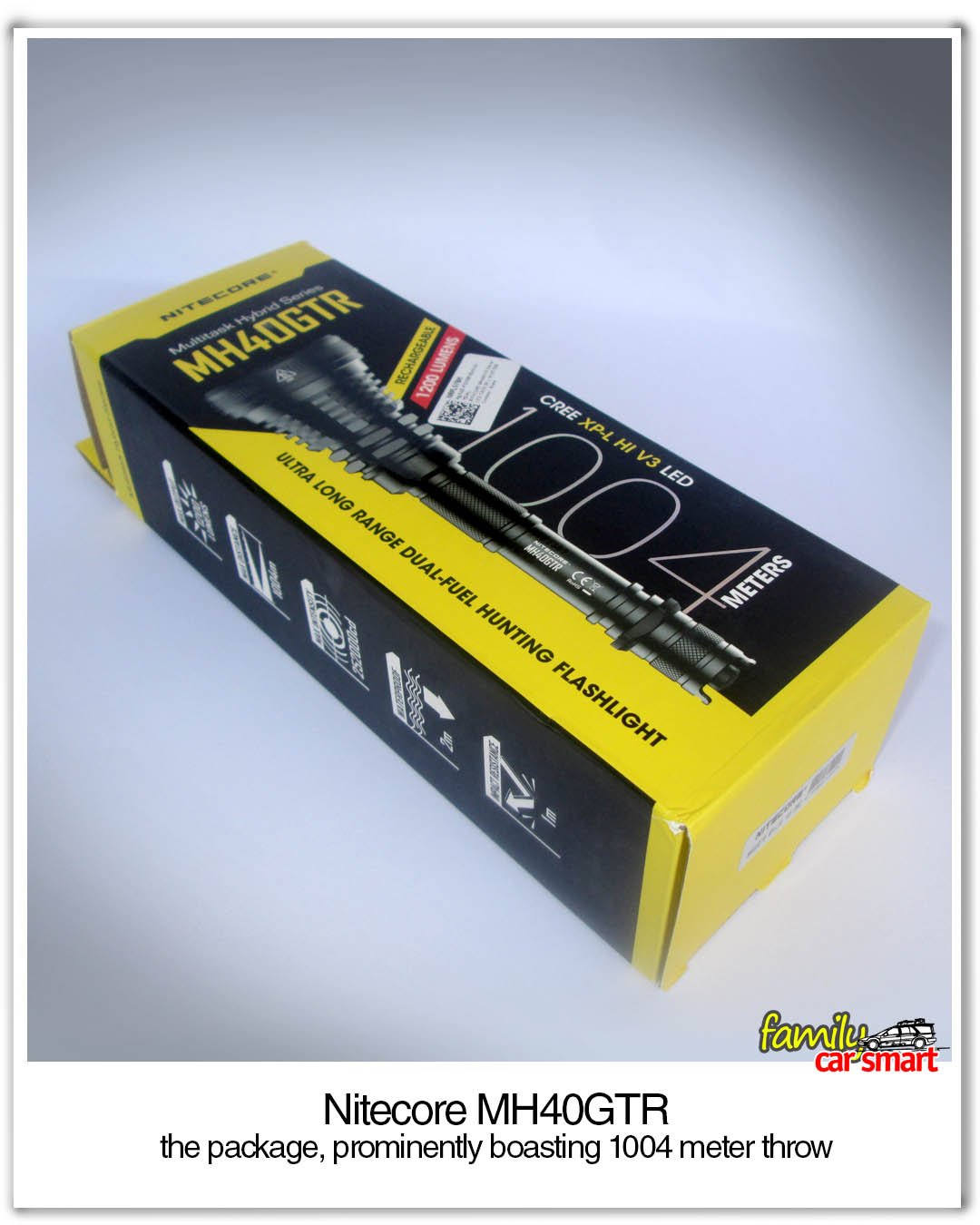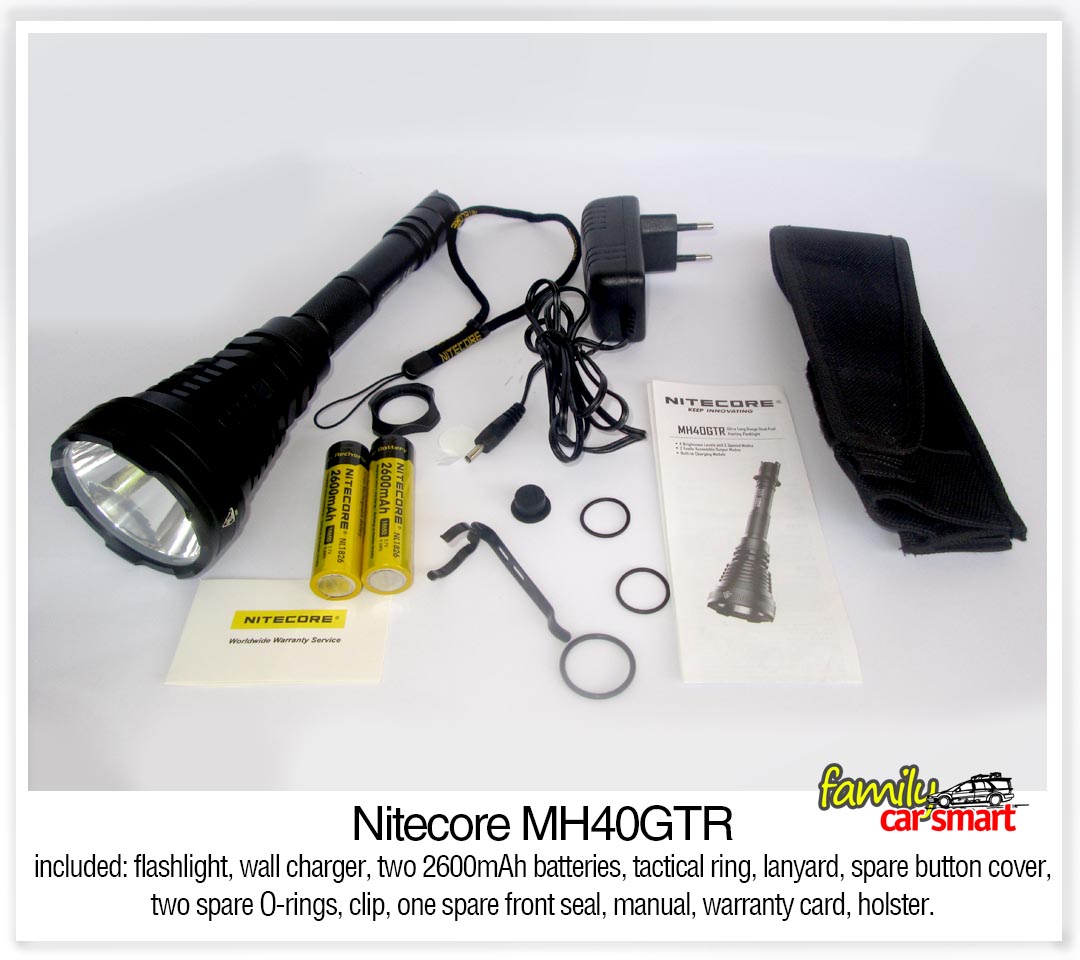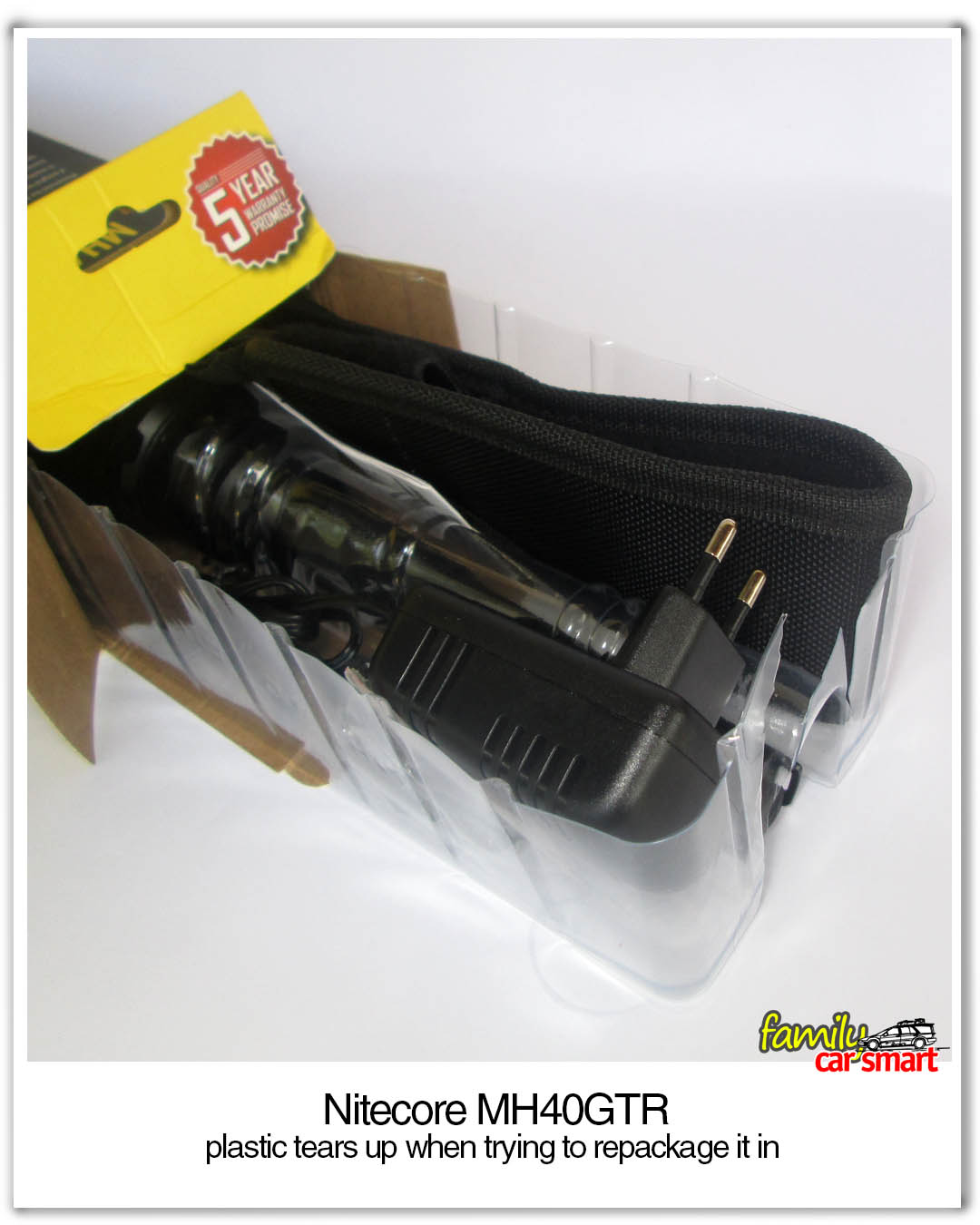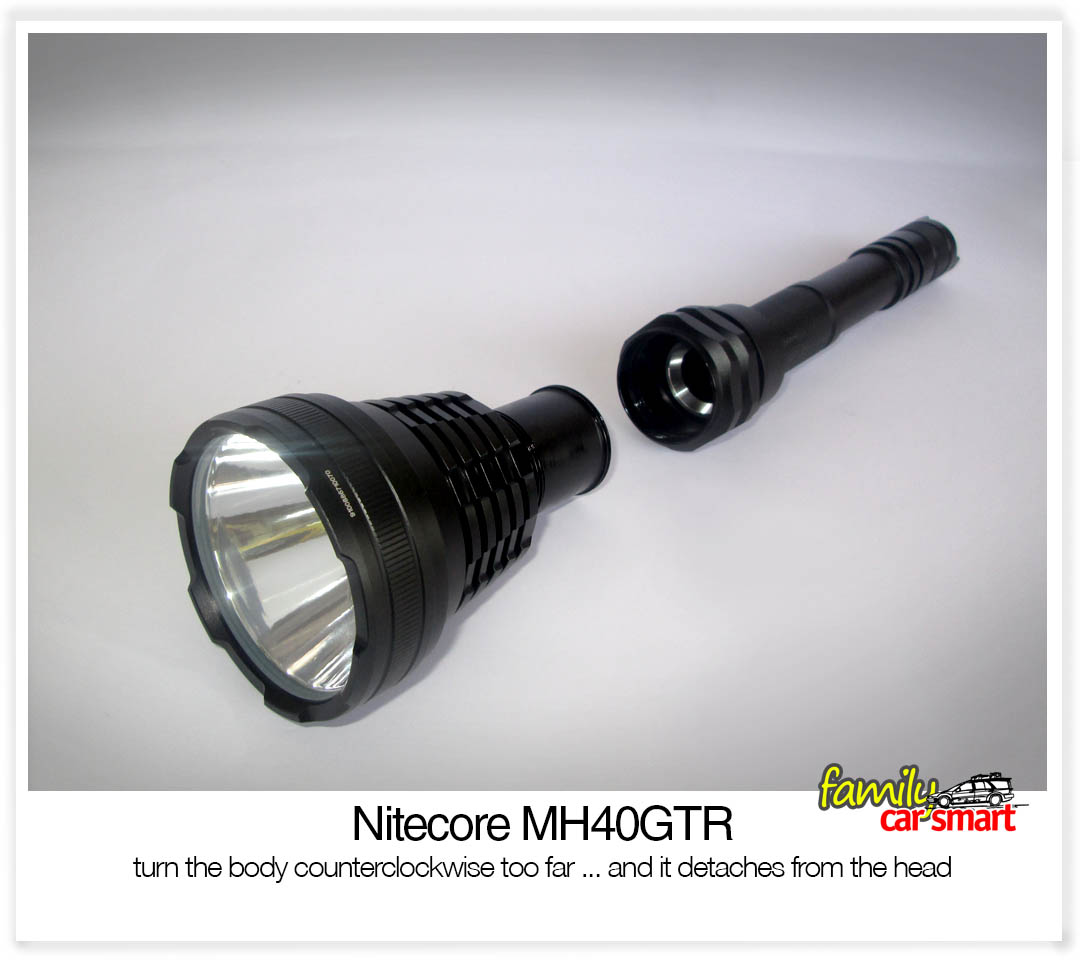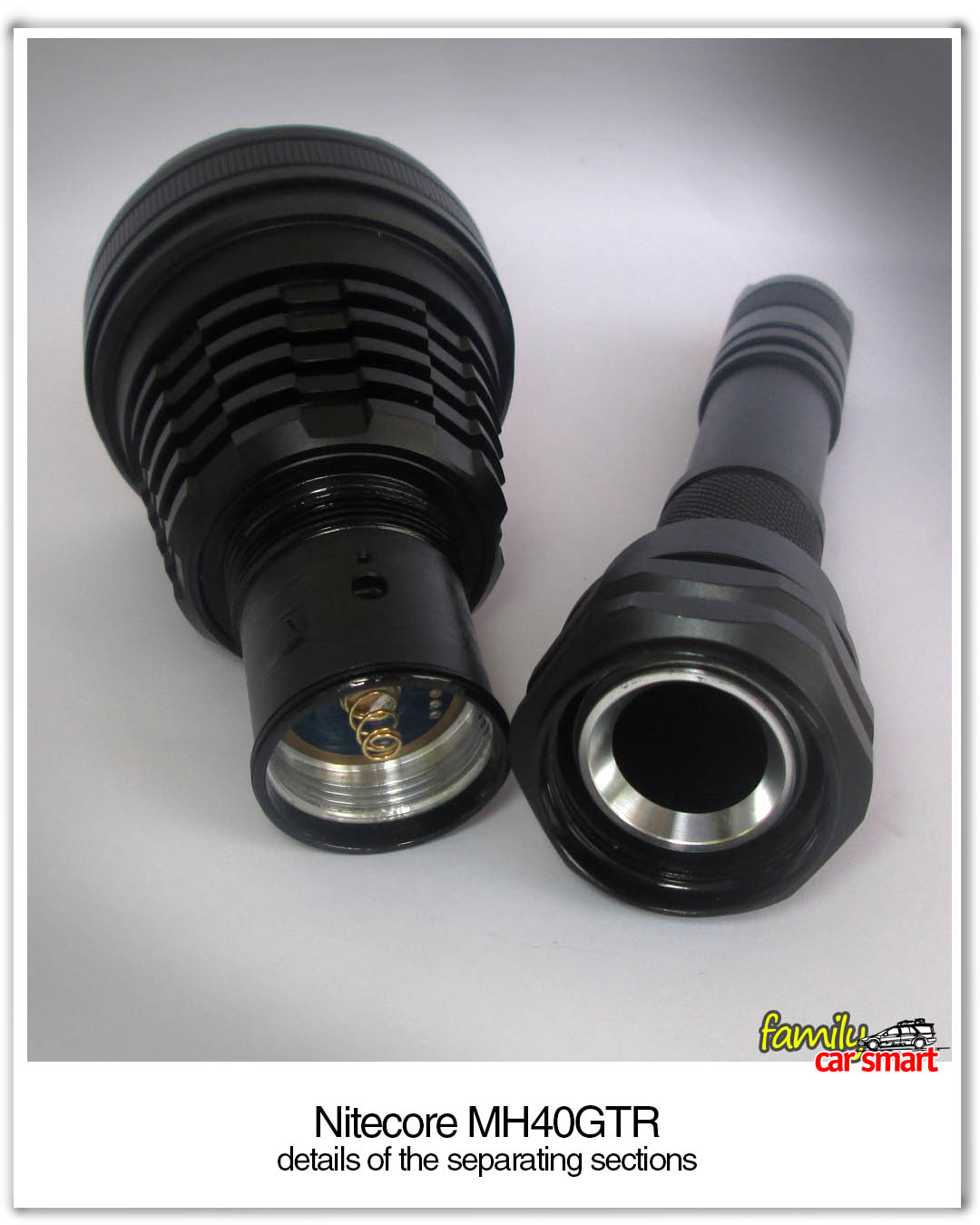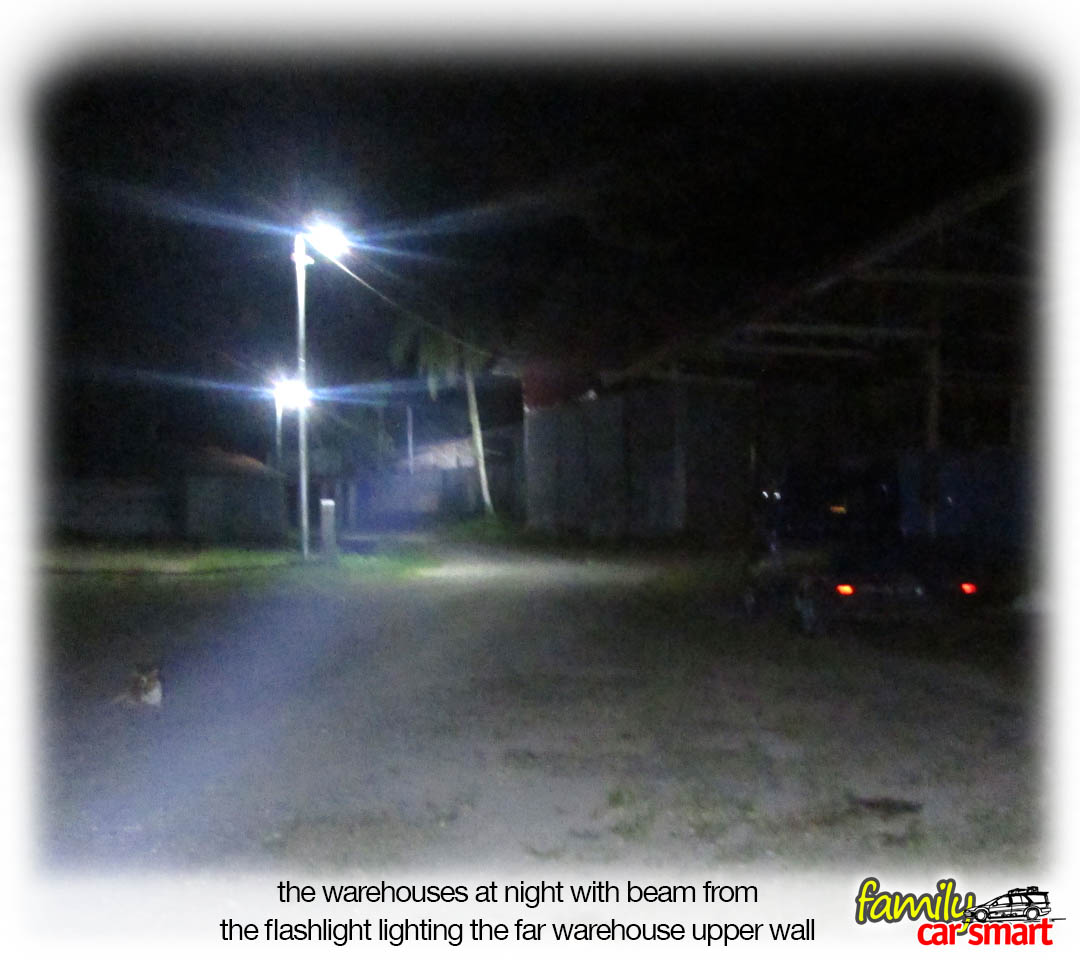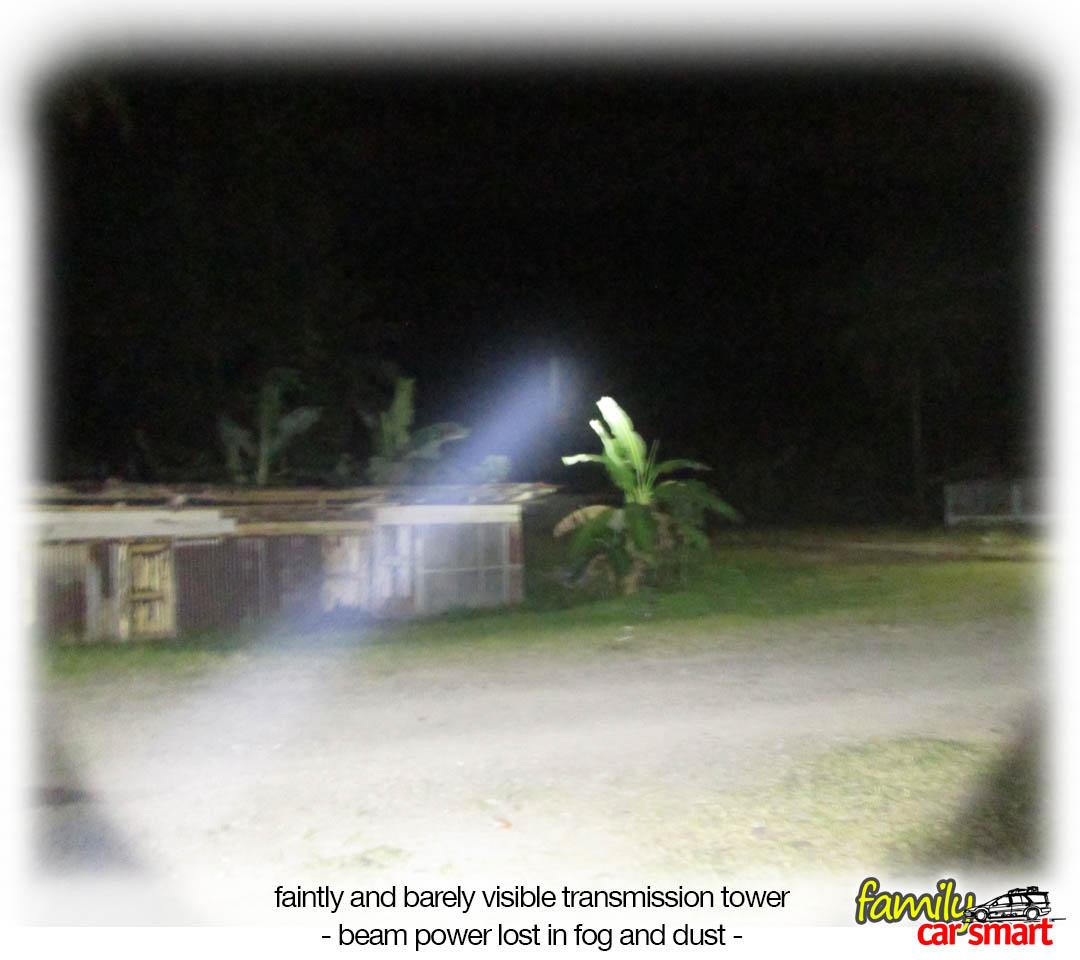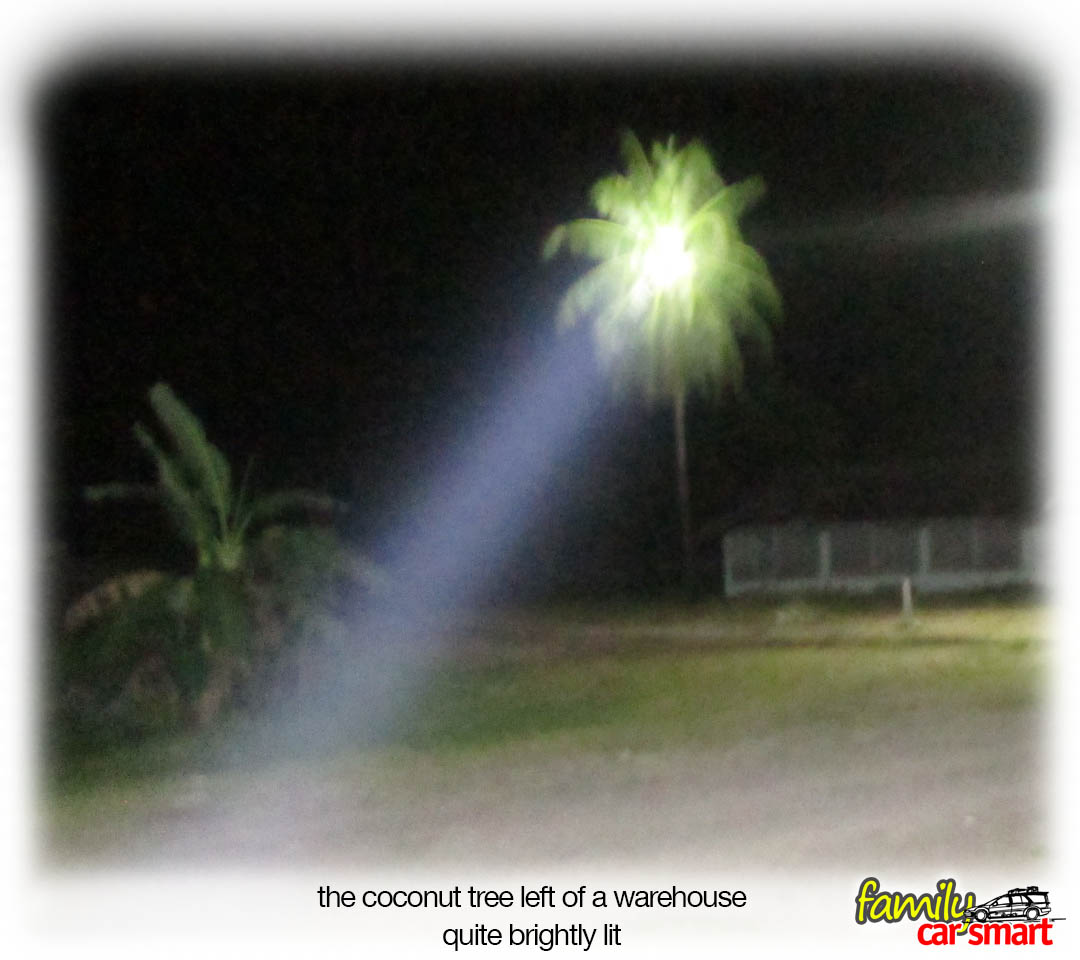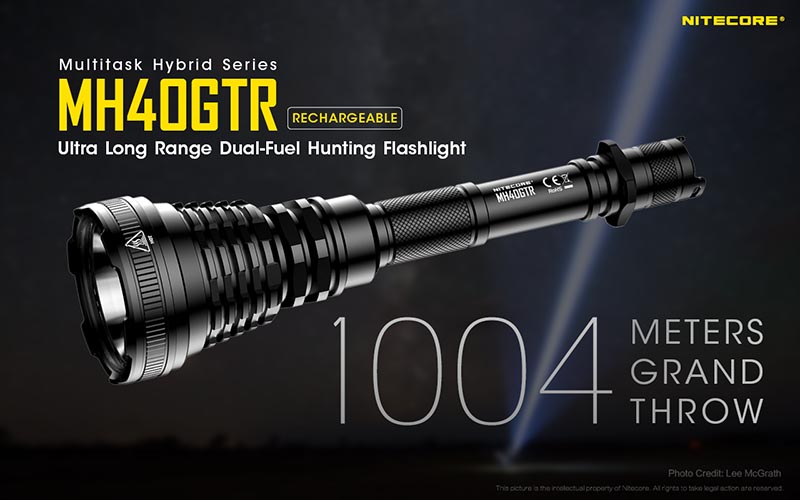
Summary
- Product Name : Nitecore MH40GTR Ultra Long Range Dual-Fuel Hunting Flashlight, Black
- Function : Long Throw, 2-Battery Rechargeable Flashlight
- Packaging : Box
- In the box : Flashlight, 2x2600mAh 18650 batteries, clip, tactical ring, lanyard, wall charger, holster, spare tail switch cover, spare O-rings.
- Price : USD 129
- Where to get it : Amazon.com
- Ease of use : ***** (batteries already in flashlight, charged, might require re-charging for continuous use.)
- Package Box Dimension : 12.8 in (32.4 cm) x 4.1 inches (10.3 cm) x 3.1 in (7.9 cm)
- Package Weight : 1.635 lb (0.75 kg)
Flashlight specification according to manufacturer
- Max Output : 1200 Lumens
- Max Beam Distance : 1,004 m
- Max Beam Intensity : 252,000 cd
- Max Runtime : 140 h 0 m / 5.83 d
- LED : CREE XP-L HI V3
- Reflector : SMO
- Battery : 2 × 18650 (button top), 4 x CR123, 3xRCR123
- Special Modes : SOS, Strobe
- Beam color : White light
- Length : 257 mm / 10.11 in
- Head Size : 70 mm / 2.75 in
- Weight : 374 g / 13.19 oz.
- Feature : Rechargeable
- Activity : Hunting, Law Enforcement, Search, Outdoor/Camping
- Warranty : 5 (five) years (may vary by countries /sellers)
- Quick recommendation : Suitable for those who have farms or like to explore the far outdoors
- Highs : In-flashlight recharge (only at home), batteries included, very bright light, good quality, waterproof (IPX8), reverse polarity protection.
- Downside : Rear button on head-heavy flashlight, not really 1004 meter useful, dim and inappropriately placed charge indicator, requires button-top batteries.
What's in this article
- How LED benefits flashlights
- Beam type choice: focus vs. flood
- The MH40GTR, description, specification and features
- Price and where to get it
- What's in the package
- Look, specification, features
- Operation and modes
- Recharging
- How the flashlight performs
- Highs and lows
- Conclusion
How LED benefits flashlight
Nowadays Flashlights use LEDs. LED is more efficient than incandescent bulbs in generating light. The progress in LEDs and rechargeable battery technology have allowed flashlight manufacturers to produce a wide variety of flashlights for specific purposes or uses. Flashlights can now pack a lot of candle power and longer battery life than in the old days. These benefits are really useful for flashlight users. But which flashlight is the right one for a purpose? Will a powerful, long-throw beam flashlight cater for your needs? Here’s a flashlight that boasts long distance range. We’ll see if it really delivers.
Beam type choice: focus vs. flood
A choice on beam pattern must be made when choosing a flashlight. This is only basic optical physics. A long-throw flashlight must concentrate the light for long reach. Because most of the light is directed to a small area at the center of the beam, the area nearby is less brightly-lit.
Meanwhile a wide-distributed light is more effective for short distance use. On flashlight we know it as flood beam. But dispersing the light in such a way weakens intensity. Hence a flood beam flashlight cannot reach as far as a flashlight with focus beam.
So when making a selection for a flashlight, this is a significant choice to make.
The Nitecore MH40GTR
This is the one with the focus beam. Designed for long, throw, the Nitecore MH40GTR uses XP-L HI V3 LED capable of producing 1,200 lumens for the purpose. The manufacturer cites maximum beam intensity of 252,000 cd. The claimed beam distance is an astounding 1,004 meters (we'll see later whether it is really effective for the range).
It requires 2 (two) 18650 button top batteries or 4xCR123 (or RCR123). Direct flashlight charging can be done with the included wall charger. The batteries are placed in-line that make the flashlight long, slim, and has a large head for the long-throw focus.
The body is made of aluminum, of several screw-on parts, one of which is to be turned to enter turbo (the brightest) mode. The flashlight has six modes (three intensities plus strobe and SOS).
Price and where to get it
You can get yours at here . It is sold at approximately USD 130 (price may vary according to additional accessories).
What's in the box
The box dimension is 12.8 in (32.4 cm) x 4.1 inches (10.3 cm) x 3.1 in (7.9 cm) with weight of 1.635 lb (0.75 kg). Nitecore uses only a formed thin plastic to accommodate the flashlight and its accessories in the box, and the plastic may tear up easily when trying to re-package the flashlight.
Look, specification, features
Dimension and weight
The flashlight dimension is 257 mm (10 inch) length with 70 mm (2.76 inch) head diameter. The dimension makes it impossible to slip it into any pocket and takes considerable space when carried in a bag. The included holster proves useful to carry it.
It packs some weight too. At 374 grams (0.82 lb), it is a bit heavy compared to other flashlights.
The following table (sorted by weight) shows the MH40GTR among some other Nitecore flashlights. We can see that it is one of the heaviest in the lineup, the type that we will always remember that we have it with us.
Power source
Nitecore cites the flashlight as "dual fuel". The flashlight is powered by two 18650, button top batteries, or 4 x CR123 or RCR123 batteries. The package includes two 18650 batteries rated at 2,600 mAh, which are quite small for the power hungry LED. The package kit includes a wall charger with wire to plug into the charging port at the neck of the flashlight.
The "dual fuel" actually refers to dual charging method, which means the batteries can be charged in-flashlight, or with an external charger. Having an external charger is certainly recommended since it will not render the flashlight unusable while used for charging. For more information, see batteries below.
Shape factor and operating hardware:
The flashlight body is made of aluminum alloy. It is quite rigid and precision made. Aluminum gives the advantage or good resistance against corrosion. The head has some ribs, which also serve as fins to disperse heat from the LED. Since the head is quite large compared to overall body, the flashlight is head-heavy.
The flashlight body itself is made of several parts. The rear part is actually screwed into the head part. There is a sleeve positioned next to the head which is screwed to the slim body. When turned counterclockwise and pulled backward, it will reveal the charging port.
The user to be careful though. If turned too far, the rear will detach from the head of the flashlight. While the body and the head are actually separate parts, this design is questionable because the body will be turned frequently to get turbo mode.
Some sections of the body has corrugated surface to help grip. Two recessed sections at the back of the body allow snapping of the included clip and the tactical ring.
How it feels: The flashlight felt quite sturdy to grip and well-built. The large head with aluminum ribs or fins gave a better impression of quality construction. It felt good on hand and gave a sense of reliability. There was no wobbling or flexure even with the heavy head.
Operation button
The flashlight has a single button placed at the end of the flashlight. The button operates the 5 modes out of 6. The turbo mode, at 1,200 lumens is accessible by turning the "neck" of the flashlight clockwise. The button has a rubber cover to protect from moisture, dirt, or other stuff. Nitecore includes one spare rubber cover for the button.
What we found: Rear cap button is very common on flashlights. They are OK for short, lightweight flashlight. But with the MH40GTR, reaching for the button to switch modes was less than convenient. Reaching for the button required the other hand to hold the body. It became impractical, especially when carrying an object. Worse if it is a gun. It would be much better if Nitecore has designed the flashlight with the button up front. Also read below on what we found on tactical ring use.
Button operation: The button controls the five modes (HIGH-MID-LOW-SOS-STROBE). Change of mode is made by pressing the rear button lightly and release it. The flashlight can remember the last used mode which will be applied the next time the flashlight is turned on.
What we found: To make the mode-memory work, the flashlight must be turned off for more than 10 seconds. When it was turned off and turned on only a few seconds later, it changed the modes. Fortunately, with the head was turned clockwise (in turbo mode), it always started in turbo, regardless of what the rear button intended to do.
Waterproofing
The flashlight is rated IPX8 for waterproofing. The end cap, where the button resides, is sealed by a rubber ring. There are 2 (two) spare rings included. Nevertheless, the charging port is concealed under the aluminum sleeve.
What we thought: We are not convinced that such protection is enough keep water out of the charging port should the flashlight becomes submerged. Thus it's better to keep the flashlight from entering any water bodies. Rain and splashes may be OK. And the threads at the front sleeve and the rear cap are greased from factory.
Reflector
The large head design clearly dictates what this flashlight is intended for. The reflector is large and deep which has a significant role in focusing the light. It is not a totally smooth type though. Some kind of circle patterns are evident when observed closely. However, the reflector has no dints or blemishes. Nitecore states that it implements PDOT (precision digital optics technology) in designing the reflector.
The LED emitter is dead center at the reflector quite precisely, which suggests a quality workmanship.
During our test, the reflector did deliver its purpose well. The light was thrown in focus without dispersion. There was no blotch, dark, or bright spots in the light distribution.
As for durability, we had to see it yet. The flashlight was only a few weeks in our hand. How the reflector resists corrosion, flaking, or discoloration, remains to be seen.
Recharging
The package includes a 12V 1A wall charger with a wire that is quite long for easy charging. A sleeve covers the charging port, and it is turned counterclockwise to loosen it to get access to the charging port.
During charging, a red indicator will blink twice a second, and will stay lit when charging is complete. The indicator also flashes rapidly if a problem occurs when charging. The flashlight must be TURNED ON when charging.
In practice, the charging worked appropriately, except when we forgot to turn the flashlight on. And the charging indicator is placed too low, and dimly lit up, It was easily concealed by the charging jack making it difficult to confirm whether charging was completed, especially when the flashlight was not close by.
Tactical ring, clip, and holster
For the long and head-heavy flashlight, the tactical ring didn’t help much for holding the flashlight. Trying to hold the flashlight while balancing it on the tactical ring put real strain on the fingers, and the flashlight always wanted to tilt down. However, the ring did help to keep the flashlight from rolling.
The clip was not quite useful either. Again due to size and weight, there won't be many objects where the flashlight would be comfortably clipped to.
And that's where the holster came in handy. It could be the only reasonable way to carry the flashlight around when not in hand. The large head actually helped to keep the flashlight steadily in the holster. However, again, due to its length, we could not just hang the holster anywhere with the flashlight in.
Batteries
The package includes two 2600 mAh button top batteries, already in the flashlight. The user can put the flashlight to use immediately.
Operation and Modes
To begin using the flashlight, a protection sheet at the back of the rear battery must be removed first. That’s it. The batteries were already installed and charged.
Unfortunately, in our test, the included batteries did not seem to be fully charged when arrived. After only about a minute of power on, the flashlight turned off unexpectedly. First we thought that it was the problem with the flashlight. But it turned out it was the batteries that needed charging.
Fortunately, a set of new 3500mAh batteries were purchased with the flashlight. But it was not we considered them necessary as spares. While Nitecore website says that batteries are included with the package, every seller we contacted (we purchased locally) stated that there were no batteries included. So the new batteries were just as a safeguard.
The flashlight provides 6 modes, 5 of which are controlled by the rear button, The modes are as in the table below.
We found that for a long head-heavy flashlight, putting the control button at the rear was cumbersome. Two hands were required to switch between modes. It would be better if Nitecore rethink about button placement on a long and heavy flashlights.
Mode changing should also be of concern. To restart the flashlight in the same mode, we had to wait about 10 seconds, or the flashlight changed modes when turned back on. A separate switch would be a good addition in this subject.
The larger capacity batteries significantly helped with such bright flashlight. We experienced considerable extra power-on with them (although we had the original batteries ready, just in case).
How the flashlight performs
The flashlight has 6 modes (see table). The highest setting is TURBO that gives 1,200 lumens. At this setting, the head of the flashlight will become warm due to emitted heat.
It really useful to 1004 meters?
The 1004 reach is the declared prominent feature on the MH40GTR. Does it really perform to the promise? Here are the samples on our test to see whether it could really reach far. The test was only done in turbo mode, which was where the flashlight should really show its usefulness.
We used the flashlight to light the areas on a vast land lot where there were warehouses, a hut, and a power transmission tower quite far away (surely not as far as 1004 m). We used it to patrol the area, checked the perimeters, and examined gates, doors, even a coconut tree from quite a distance away.
Here are the samples.
As the pictures show, the flashlight really did a long throw, with sufficient brightness on the near area (remember, this was in turbo mode). It was very capable and usable for such aforementioned purpose.
On the warehouses:
The flashlight is very useful in lighting up the warehouses at some distance away. We can see that it shines on the warehouse’s wall quite brightly. Should there was anyone there or, we could have easily spotted him.
On the coconut tree: Yes, again it is quite brightly lit. Only the camera could not focus appropriately, or else we could have seen how many fruit were hanging.
On the transmission tower.
This one tells a different story. The electricity transmission tower surely does not sit 1004 meters away. It’s about less than half that distance. It is easy to see that the tower is only barely visible as blur white object (you might have to observe where the beam path ends). That blur white vertical bar is the tower.
The coconut tree was only about 60 meters away. The warehouse was about twice as far. The transmission tower was less than 500 meters . It is evident that at any of the lightings, dust particles in the air already interfered. The interference got worst as the distance increased. Users certainly will never have an ideal atmosphere condition where the air is totally clean of any optics disturbing particles. We believe the flashlight could not be effective for a distance as far as 1000 m.
Conclusion
For the design, it serves its rather specific purpose well. Exploring a vast piece of land will certainly find this flashlight useful.
Although it might not reach the designed 1004 m range, the capability is quite satisfactory.
Size and weight and should be of concern in carrying this flashlight around (preferably using the holster). Spare batteries (button tops) are recommended.
Again, from the look and (head) size, it is easy to see that this could not be an everyday, around the house flashlight. If you want to have only one flashlight for every purpose, this is NOT it. Another smaller, flood beam flashlight is more suitable. While the 1004 meter citation is enticing, consumers should not be tempted to get an MHGTR40 only due to its large size, lumens, or range. This one flashlight is better suits the purpose of hunting, exploring distant areas, search, or checking out a farm.
For general around the house (and car) use, here are some other Nitecore products that might suit your needs:
- New P12, USD 89.95, a smaller form flashlight that also packs high power light (1200 lumens max, runs on single 21700 or 18650 type battery, throw light to 234 meters /267 yards).
- The more versatile MT21C, USD 63.99, produces 1000 lumens max, single 18650 battery, tiltable head, 1000 lumens, and magnetic base.
- The smaller and cheaper MT21A . USD 35, can do 260 lumens max, runs on 2 AA batteries.
Finally, these are the summaries for the considerations for purchasing the Nitecore MH40GTR.
Highs:
- Bright LED with good range.
- Instant access to turbo mode (requires 2 hands)
- Comes with batteries
- Can take CR123 batteries
- Includes two 18650 button top batteries.
- Anti rolling design
- Includes button rubber cover spares
- IPX8 waterproof
- Remembers its last mode
Lows:
- Not really 1,004 meter useful
- Access to turbo mode requires 2 hands.
- End cap button could be annoying for a long and heavy headlight.
- Requires button top batteries (our stacks of flat-top batteries do not work).
- Charging indicator almost invisible (dim and too low positioned).
- The included batteries are only rated at 2,600 mAh. Getting higher capacity batteries (remember, they must be bottom tops) is recommended.
- Not a flashlight to work around a car or the house. You'll still need another flashlight.
- Not a pocketable flashlight, the holster proves useful.
- Don’t forget to turn it on while charging.
However, if you think this is the (other) flashlight that you need, you can get it here.
Thank you for visiting this site. We hope the information is useful for the readers. Don’t hesitate to leave comments or questions if you feel like so, or email us at info@familycarsmart.com.
